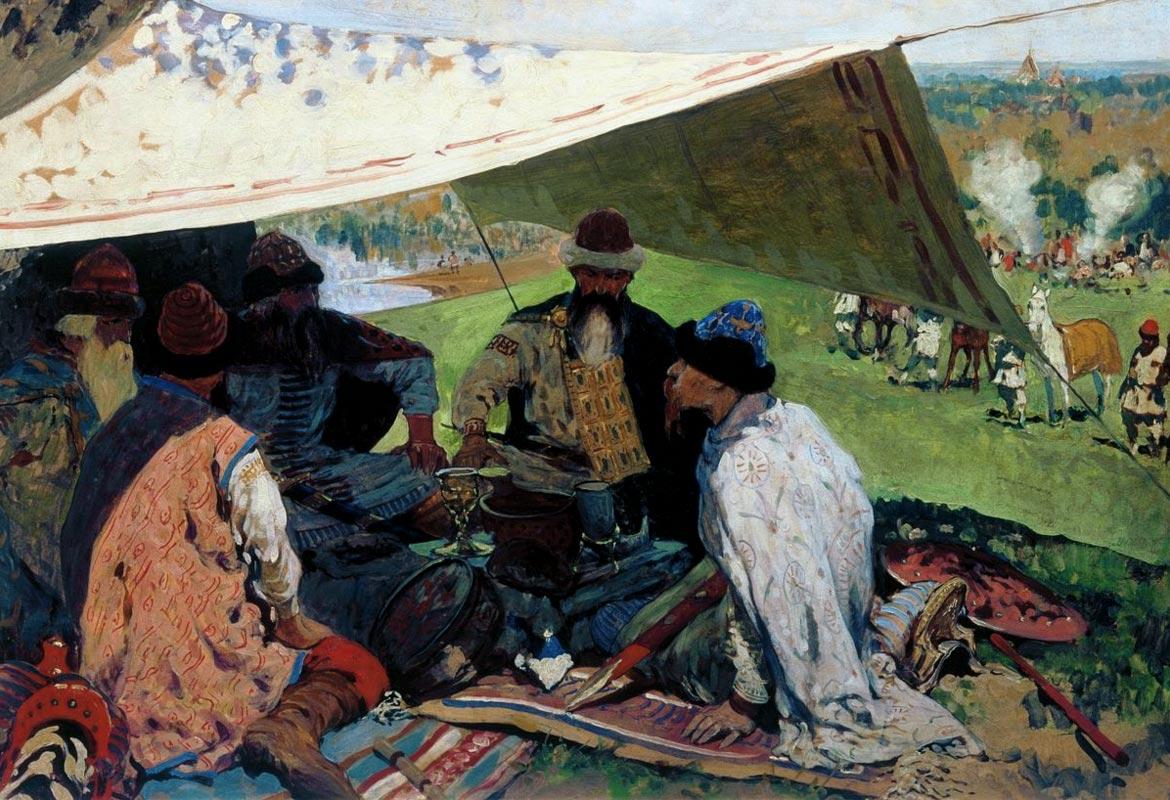Foundation of the House
The history of the Ukrainian monarchy and of the House of Rurikovich dates back more than a thousand years to 862 when Varangian chieftain Rurik conquered a Slavic outpost of Ladoga (today's Russia) and founded the city of Novgorod the same year.
When Rurik died in 879, his heir and son Igor was 2 y.o., and Oleg the Seer started reigning in his name as a regent.
In 882 Oleg the Seer conquered Kyiv from the semi-legendary prince Askold and moved his capital there, proclaiming Kyiv the Mother of all Rus' cities. Since that and for more than 500 years, Kyiv will remain the domain of the House of Rurikovich.
In 907, after many years of Byzantine raids on Rus', Oleg started a campaign against the Byzantine Empire that ended with Constantinople being besieged, Oleg nailing his shield to the gates of Constantinople, and Byzantine Emperor Leo VI begging for peace. According to the provisions of the peace treaty, the Empire agreed to pay tribute to Rus' and lift all trade restrictions. Those provisions were confirmed in the Rus'–Byzantine Treaty of 911; as an example of the treaty's favorability to Rus', Kyivan merchants were granted the right to live in Constantinople for half a year, and all their living expenses were covered by the Empire. Most importantly, however, the treaty recognized Oleg as the Grand Prince of Rus'.
In 912 Oleg passed away. Rurik's son Igor ascended to the throne and reigned for 33 years till his assassination by hostile tribes in 945. Similarly to Igor himself, his son Sviatoslav was 3 y.o. by the time, and Igor's wife Olga became regent for her underage son.
Princess Olga went down in history as the first Rus’ monarch who professed Christianity — the reason for her veneration as a saint in both Orthodox and Catholic Churches — but during her reign, the country as a whole remained largely pagan. Her son Sviatoslav, who assumed the throne in 962, was a staunch pagan. Sviatoslav’s son Yaropolk, who succeeded his father in 972 and reigned till 980, was a pagan as well, even though rumors suggested he was about to undergo baptism at the time of being murdered.
It was not until 988 when Vladimir — dubbed Vladimir the Great, the second son of Sviatoslav — baptized Rus' into the Byzantine rite, and effectively recreated Constantinople in Kyiv, even building his own Cathedral of Hagia Sophia. Vladimir the Great is credited with consolidating the Kyivan realm and considered the founding father of all three East Slavic countries: Ukraine, Belarus, and Russia.
When in 1019 Vladimir's son Yaroslav became the Grand Prince of Kyiv, after a political struggle against his siblings he secured an alliance with the Scandinavians and transformed Kyivan Rus' into one of the most powerful states on the European continent, and even destroyed the Byzantine fleet in 1043. Yaroslav's family played an important role in European history: his elder daughter Anastasia became the Queen Consort of Hungary, middle daughter Elisiv the Queen Consort of Norway, and younger daughter Anne the Queen Consort of France.
The medieval history of the Ukrainian Royal Family includes many prominent names, and to provide a full chronicle on a single page would be impossible. And yet, we can't not mention Michael of Chernigov — one of the most prominent Rus' princes, the founder of the Olgovichi family who stood up against the Mongols and was executed in 1246 at the camp of Batu Khan for refusing to betray the Christian faith. His martyrdom earned made him one of the most venerated Orthodox saints, regarded as the defender of the Rus' nation.
Exile
When Fyodor Simeonovych (b. 1574), the son of a Rurikid princess Anastasiia Mstislavska and Simeon Bekbulatovich — the last person to reign as the Grand Prince of Rus' — was exiled by the usurper and self-proclaimed "Tsar" Boris Godunov, who orchestrated the murder of 8 y.o. prince Dmitry of Uglich, Rus' entered dark ages. The country that used to be one of the strongest European players, was a respectable member of the European family of nations and scored prominent victories against the Byzantine Empire, went into isolation the effects of which are still witnessed today.
Simeon Bekbulatovich was blinded by Boris Godunov and died in Moscow in 1616. After the exile of Fyodor Simeonovych, the line of the Ukrainian Royal Family continued to his son Fyodor Fyodorych (b. 1602), to his son Mikhajlo Fyodorich (b. 1639), to his daughter Yevdokia Mikhajlovna (b. 1673). Yevdokia Mikhajlovna married into a family of Polish landowners Lubomirski (not to be confused with the Polish Princely family of the same name). She had a son Franciszek (Frantsysk) (b. 1707) to his son Andrzej (Andrej) (b. 1743) to his daughter Mariia (b. 1780). Mariia married into a family of Western-Ukrainian nobles Kysil. Her daughter Julia (b. 1809) had a son who settled in the Low Lands (the Netherlands) named Mikhajlo (Nicolaas) (b. 1853), his son Ioann (Johannes) (b. 1881) to his son Albert (b. 1921), to his son Grand Prince Ioann Albertovych who revived the claim in 2015.
The revival of the House
Grand Prince Ioann Albertovych, only had two daughters and after the passing of the Statute of the Ukrainian Royal Family proclaimed on 2 November 2019 a Decree, establishing his eldest grandson through his eldest daughter the current Grand Prince Dionisiy Reshatovych as his successor. On 7 February 2020 Grand Prince Ioann Albertovych abdicated due to his old age and was succeeded by Dionisiy Reshatovych.
Grand Prince Dionisiy Reshatovych is through paternal lineage also a direct-descendant (albeit an illegitimate one) of the Crimean Khans.

